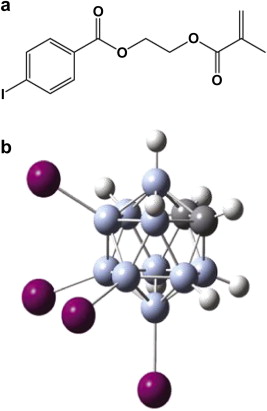
Pepiol A, Teixidor F, Saralidze K, van der Marel C, Willems P, Voss L, Knetsch ML, Vinas C, Koole LH.
Bone cements for vertebroplasty must have a much better radiocontrast level than cements for knee or hip arthroplasty. This is generally accomplished by adding a relat
ively large portion of BaSO(4), although this affects the physical-mechanical and biological properties of the cement. This prompted us to develop an alternative radiopaque
cement, on the basis of unique highly radiopaque methacrylic microspheres. These contain iodine in two modalities: (i) covalently linked to the methacrylic polymer, and (ii) as constituent of the stable tetraiodocarborane 8,9,10,12-I(4)-1,2-closo-C(2)B(10)H(8). The total iodine content in these particles exceeded 30% by mass. These radiopaque microspheres as well as the cement made thereof were characterized extensively, e.g., by scanning electron microscopy, X-ray contrast measurements, X-ray photoelectron spectroscopy, measurements of compressive strength, infrared spectroscopy, and solid state (11)B{(1)H} NMR spectroscopy. Furthermore, the new cement was subjected to several biocompatibility tests in vitro. The results show that the new bone cement fulfills all physico-chemical criteria for use in vertebroplasty. Further data on the cement’s biocompatibility (in vitro), as well as on the handling parameters and doughviscosity, indicate that this material has a potential to become an alternative to vertebroplasty cements with a high BaSO(4) content. The new cement provides two significant advantages: (i) controlled viscosity in the dough phase, which facilitates precise injection during the vertebroplasty procedure; (ii) excellent structural stability, which precludes leaching of contrast post-implantation.
http://www.sciencedirect.com/science/article/pii/S0142961211006016
